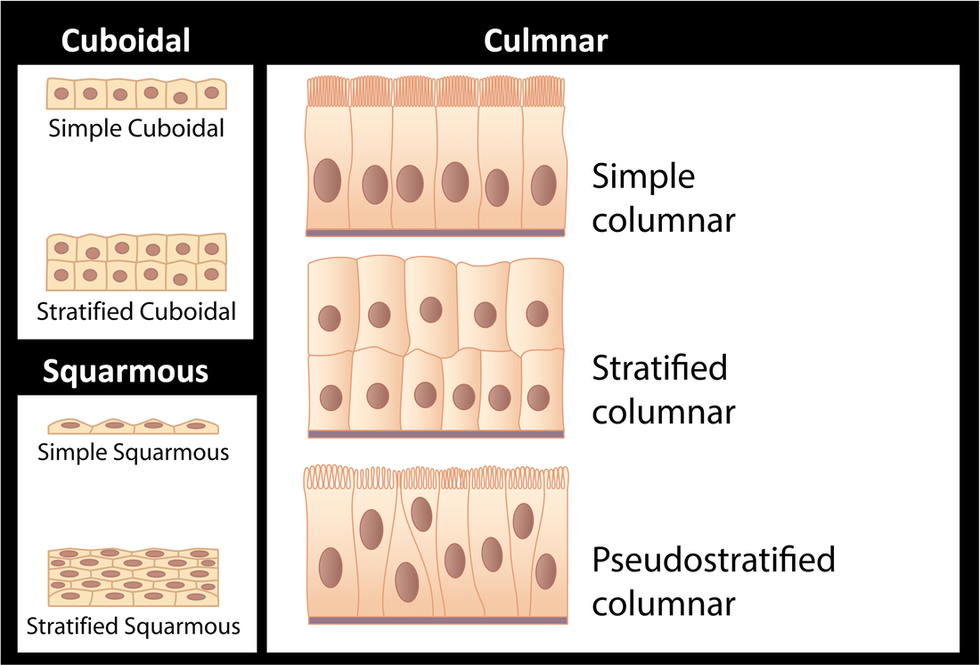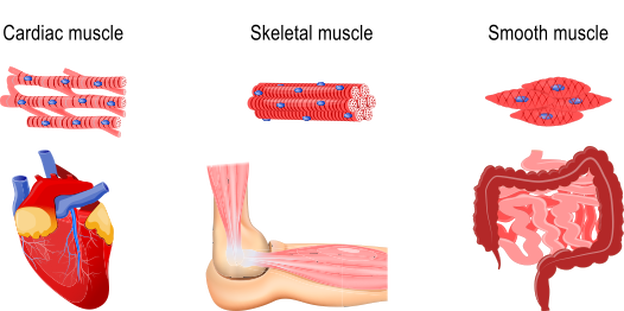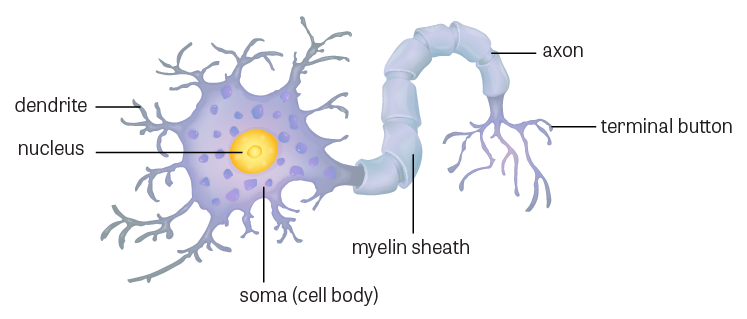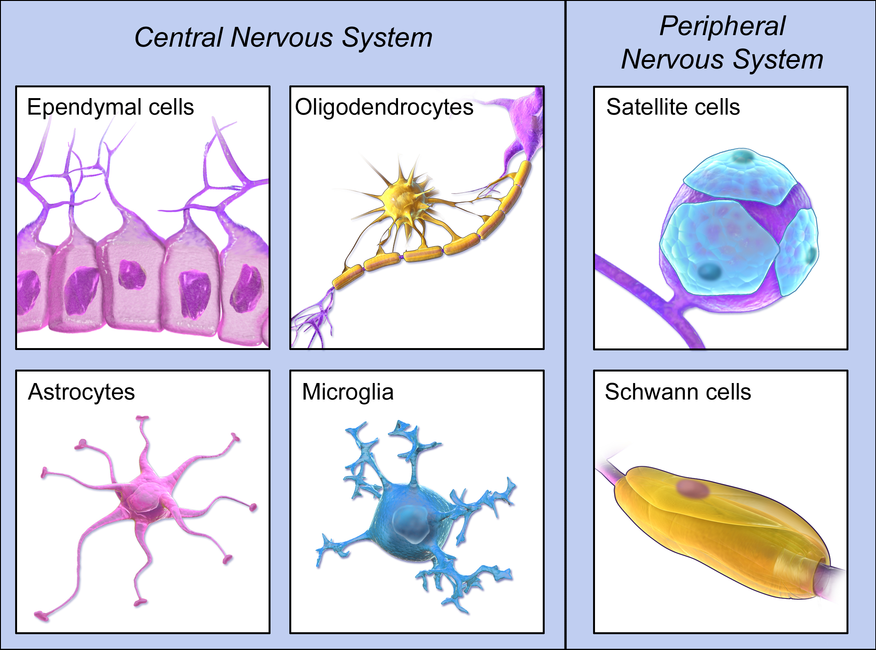Tissues
There are four types of tissues dispersed throughout the body, as described below. A type of tissue is not unique for a particular organ and all types of tissue are present in most organs, just as certain types of cells are found in many organs. For example, nerve cells and circulating blood cells are present in virtually all organs.
An "Orchestra" of Tissues
Tissues in organs are precisely arranged so that they can work in harmony in performing organ functions. This is similar to an orchestra that contains various musical instruments, each of which is located in a precise place and contributes exactly at the right time to create harmony. Like musical instruments that are mixed and matched in various types of musical groups, tissues and cells also are present in several different organs and contribute their part to the function of the organ and the maintenance of homeostasis.
Kinds of Tissues in the Body
The four types of tissues are:
An "Orchestra" of Tissues
Tissues in organs are precisely arranged so that they can work in harmony in performing organ functions. This is similar to an orchestra that contains various musical instruments, each of which is located in a precise place and contributes exactly at the right time to create harmony. Like musical instruments that are mixed and matched in various types of musical groups, tissues and cells also are present in several different organs and contribute their part to the function of the organ and the maintenance of homeostasis.
Kinds of Tissues in the Body
The four types of tissues are:
- Epithelial tissue
- Connective tissue
- Muscle tissue
- Nerve tissue
Figure 1. Hierarchy of body components
(Image Source: NLM)
(Image Source: NLM)
Epithelial Tissue
Epithelial tissue is specialized to protect, absorb, and secrete substances, as well as detect sensations. It covers every exposed body surface, forms a barrier to the outside world, and controls absorption. Epithelium forms most of the surface of the skin, and the lining of the intestinal, respiratory, and urogenital tracts. Epithelium also lines internal cavities and passageways such as the chest, brain, eye, inner surfaces of blood vessels, the heart, and the inner ear.
Functions of epithelium include:
The epithelial cells are classified according to the shape of the cell and the number of cell layers. Three primary cell shapes exist: squamous (flat), cuboidal, and columnar. There are two types of layering: 1) simple and 2) stratified. Figure 2 illustrates these types of epithelial cells.
Epithelial tissue is specialized to protect, absorb, and secrete substances, as well as detect sensations. It covers every exposed body surface, forms a barrier to the outside world, and controls absorption. Epithelium forms most of the surface of the skin, and the lining of the intestinal, respiratory, and urogenital tracts. Epithelium also lines internal cavities and passageways such as the chest, brain, eye, inner surfaces of blood vessels, the heart, and the inner ear.
Functions of epithelium include:
- Providing physical protection from abrasion, dehydration, and damage by xenobiotics.
- Controlling the permeability of substances in entering or leaving the body.
- Some epithelia are relatively impermeable; others are readily crossed.
- Various toxins can damage this epithelial barrier.
- Detecting sensation (sight, smell, taste, equilibrium, and hearing) and conveying this information to the nervous system.
- For example, touch receptors in the skin respond to pressure by stimulating adjacent sensory nerves.
The epithelial cells are classified according to the shape of the cell and the number of cell layers. Three primary cell shapes exist: squamous (flat), cuboidal, and columnar. There are two types of layering: 1) simple and 2) stratified. Figure 2 illustrates these types of epithelial cells.
Figure 2. Classification of epithelial tissues
(Source: Adapted from iStock Photos, ©)
(Source: Adapted from iStock Photos, ©)
Connective Tissue
Connective tissues provide support and hold the body tissues together. They contain more intercellular substances than the other tissues. Connective tissues include blood; bone; cartilage; adipose (fat); and the fibrous and areolar (loose) connective tissues that give support to most organs. The blood and lymph vessels are immersed in the connective tissue media of the body. The blood-vascular system is a component of connective tissue.
In addition to connecting, the connective tissue plays a major role in protecting the body from outside invaders. The hematopoietic tissue is a form of connective tissue responsible for the manufacture of all the blood cells and immunological capability. Phagocytes are connective tissue cells and produce antibodies. If invading organisms or xenobiotics get through the epithelial protective barrier, the connective tissue acts to defend against them.
Connective tissues provide support and hold the body tissues together. They contain more intercellular substances than the other tissues. Connective tissues include blood; bone; cartilage; adipose (fat); and the fibrous and areolar (loose) connective tissues that give support to most organs. The blood and lymph vessels are immersed in the connective tissue media of the body. The blood-vascular system is a component of connective tissue.
In addition to connecting, the connective tissue plays a major role in protecting the body from outside invaders. The hematopoietic tissue is a form of connective tissue responsible for the manufacture of all the blood cells and immunological capability. Phagocytes are connective tissue cells and produce antibodies. If invading organisms or xenobiotics get through the epithelial protective barrier, the connective tissue acts to defend against them.
Figure 3. Connective tissues
(Image Source: Adapted from Wikimedia Commons, Public Domain)
(Image Source: Adapted from Wikimedia Commons, Public Domain)
Muscle Tissue
Muscular tissue is specialized for an ability to contract. Muscle cells are elongated and called muscle fibers. When one end of a muscle cell receives a stimulus, a wave of excitation is conducted through the entire cell so that all parts contract in harmony.
There are three types of muscle cells:
Muscular tissue is specialized for an ability to contract. Muscle cells are elongated and called muscle fibers. When one end of a muscle cell receives a stimulus, a wave of excitation is conducted through the entire cell so that all parts contract in harmony.
There are three types of muscle cells:
- Skeletal muscle — attached to bone and contracts causing the bones to move.
- Cardiac muscle — contracts to force blood out of the heart and around the body.
- Smooth muscle — can be found in several organs, including the digestive tract, reproductive organs, respiratory tract, and the lining of the bladder. Examples of smooth muscle activity are the:
- Contraction of the bladder to force urine out.
- Peristaltic movement to move feces down the digestive system.
- Contraction of smooth muscle in the trachea and bronchi which decreases the size of the air passageway.
Figure 4. Muscle tissues
(Image Source: iStock Photos, ©)
(Image Source: iStock Photos, ©)
Nerve Tissue
Nervous tissue is specialized with a capability to conduct electrical impulses and convey information from one area of the body to another. Most of the nervous tissue (98%) is located in the central nervous system, the brain, and spinal cord.
There are two types of nervous tissue: 1) neurons and 2) neuroglia. Neurons (Figure 5) actually transmit the impulses. Neuroglia (Figure 6) provide physical support for the neural tissue, control tissue fluids around the neurons, and help defend the neurons from invading organisms and xenobiotics. Receptor nerve endings of neurons react to various kinds of stimuli (for example, light, sound, touch, and pressure) and can transmit waves of excitation from the farthest point in the body to the central nervous system.
Nervous tissue is specialized with a capability to conduct electrical impulses and convey information from one area of the body to another. Most of the nervous tissue (98%) is located in the central nervous system, the brain, and spinal cord.
There are two types of nervous tissue: 1) neurons and 2) neuroglia. Neurons (Figure 5) actually transmit the impulses. Neuroglia (Figure 6) provide physical support for the neural tissue, control tissue fluids around the neurons, and help defend the neurons from invading organisms and xenobiotics. Receptor nerve endings of neurons react to various kinds of stimuli (for example, light, sound, touch, and pressure) and can transmit waves of excitation from the farthest point in the body to the central nervous system.
Figure 5. Human neuron anatomy
(Image Source: Adapted from iStock Photos, ©)
(Image Source: Adapted from iStock Photos, ©)
Figure 6. Types of neuroglia
(Image Source: Adapted from Wikimedia Commons. Blausen.com staff (2014). "Medical gallery of Blausen Medical 2014". WikiJournal of Medicine 1 (2). DOI:10.15347/wjm/2014.010. ISSN 2002-4436. View original image.)
(Image Source: Adapted from Wikimedia Commons. Blausen.com staff (2014). "Medical gallery of Blausen Medical 2014". WikiJournal of Medicine 1 (2). DOI:10.15347/wjm/2014.010. ISSN 2002-4436. View original image.)
Knowledge Check (Solutions on next page)
1) There are only four types of tissues in the body. The type of tissue that is specialized to protect, absorb and secrete substances, detect sensations, covers every exposed body surface, and forms a barrier to the outside world is:
a) Nerve tissue
b) Epithelial tissue
c) Connective tissue
d) Muscle tissue







